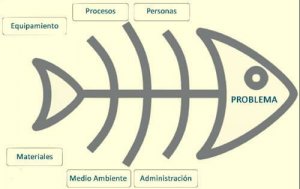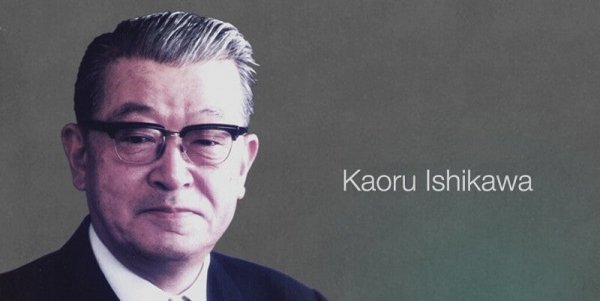Using the Ishikawa Diagram for Problem Solving


Written and verified by the psychologist Valeria Sabater
The Ishikawa diagram, also known as the fishbone diagram, is an essential tool in any company’s quality management processes. Thanks to this tool, existing problems can be analyzed by clarifying their causes. It also allows workgroups to understand what obstacles are hindering the organization’s potential.
The origin of this technique isn’t Anglo-Saxon. The Japanese are great business strategists and there’s a good reason why a good percentage of their products, technology, and resources are in prominent positions in our market.
Karou Ishikawa, a Japanese industrial chemist and business administrator, introduced this idea in 1943. Today, Ishikawa is considered one of the great gurus in quality management processes.
Not only do we owe him the now famous fish diagram to analyze potential causes of problems in businesses, but he was also one of the first people to emphasize the need to introduce total quality control in production. He stated that it should involve each and every person in the workplace, from the top management to the very bottom.
For Ishikawa, quality was synonymous with responsibility, ethics, and education. If someone neglects these principles, then the goals won’t be achieved. Likewise, every team needs, according to its approach, resources to be able to monitor its progress, problems, and existing obstacles. The Ishikawa diagram is one of them. Learn about it below!

What’s the Ishikawa diagram?
While it’s true that the Ishikawa diagram is mostly used in the business environment, you can actually make use of it in many more contexts. After all, it’s a good mental strategy for analyzing the causes of problems.
However, it’s interesting to know more about its two areas of application. That’s why we’re going to analyze the two ways of using the famous fish diagram devised by Kaoru Ishikawa.
The cause-effect diagram at a company level with teams
Any company, no matter how small, faces its daily challenges in varying degrees of effectiveness. One way to improve effectiveness is to know how to deal with incidents, problems, and disagreements that can arise at any time.
Ishikawa’s diagram can help solve these potential pitfalls in an ingenious way. Here are its keys:
- All members (or at least someone representing them) in the organization must be present.
- Firstly, the problem is defined. For example, low production in the last quarter. That’ll be the “head of the fish”, or in this case, the effect.
- Once the problem is clarified, you need to trace the bones of the fish, and this will define the causes.
- To do this, you have to follow the following process, which outlines the points of analysis or reflection:
- Methods
- Machines (equipment)
- People (workers)
- Materials
- Administration
- Work environment
Each person must contribute by suggesting what factors, in their opinion, and according to their experiences, have caused this problem.
The last step is the most decisive one: to resolve the problem, using all the causes that have been identified by the employees.
The Ishikawa diagram for personal growth
As we pointed out above, the Ishikawa diagram doesn’t have to be limited to social and business spheres. It can also become an ideal strategy in the area of personal growth.
It can become a highly effective tool to identify the areas and problems that are limiting your well-being. You can make use of this methodology and apply it to almost any real-life scenario.
So how can you apply it in your daily life? How can it help you to achieve happiness or certain goals? Take a look at the following steps!
- Firstly, identify the concern, fear, emotional barrier, or problem. For example, “I feel stressed”.
- Secondly, as you’ve seen already, you need to arrange the fish bones. These are the factors that have caused the problem. In this case, the problem is stress. To do this, you can use the following questions as a guide:
- How do I spend my time?
- Do I have a healthy self-image?
- What kind of thoughts do I usually have about myself or life in general?
- What people do I have around me?
- Am I taking any positive steps to feel better?
Solving the problem
The last step of the Ishikawa diagram, when applied to the field of personal growth or well-being, is, once again, the most important one. Once you’ve managed to identify and become aware of the things that are causing your distress, or the factors that are hindering you from achieving what you want (whether it’s reducing stress, achieving a goal or making changes in your life), it’s time to consider potential solutions.
There’s no point in using this famous fish diagram if it’s not going to help you make improvements in your life. Thus, don’t hesitate to use this unique resource for your own benefit! It’s a valuable exercise in self-analysis that also helps you to exercise creativity in order to make improvements.
Why don’t you let this unusual amphibian help you swim to a brighter and happier ocean? We’re sure it’ll help take away that sinking feeling!
The Ishikawa diagram, also known as the fishbone diagram, is an essential tool in any company’s quality management processes. Thanks to this tool, existing problems can be analyzed by clarifying their causes. It also allows workgroups to understand what obstacles are hindering the organization’s potential.
The origin of this technique isn’t Anglo-Saxon. The Japanese are great business strategists and there’s a good reason why a good percentage of their products, technology, and resources are in prominent positions in our market.
Karou Ishikawa, a Japanese industrial chemist and business administrator, introduced this idea in 1943. Today, Ishikawa is considered one of the great gurus in quality management processes.
Not only do we owe him the now famous fish diagram to analyze potential causes of problems in businesses, but he was also one of the first people to emphasize the need to introduce total quality control in production. He stated that it should involve each and every person in the workplace, from the top management to the very bottom.
For Ishikawa, quality was synonymous with responsibility, ethics, and education. If someone neglects these principles, then the goals won’t be achieved. Likewise, every team needs, according to its approach, resources to be able to monitor its progress, problems, and existing obstacles. The Ishikawa diagram is one of them. Learn about it below!

What’s the Ishikawa diagram?
While it’s true that the Ishikawa diagram is mostly used in the business environment, you can actually make use of it in many more contexts. After all, it’s a good mental strategy for analyzing the causes of problems.
However, it’s interesting to know more about its two areas of application. That’s why we’re going to analyze the two ways of using the famous fish diagram devised by Kaoru Ishikawa.
The cause-effect diagram at a company level with teams
Any company, no matter how small, faces its daily challenges in varying degrees of effectiveness. One way to improve effectiveness is to know how to deal with incidents, problems, and disagreements that can arise at any time.
Ishikawa’s diagram can help solve these potential pitfalls in an ingenious way. Here are its keys:
- All members (or at least someone representing them) in the organization must be present.
- Firstly, the problem is defined. For example, low production in the last quarter. That’ll be the “head of the fish”, or in this case, the effect.
- Once the problem is clarified, you need to trace the bones of the fish, and this will define the causes.
- To do this, you have to follow the following process, which outlines the points of analysis or reflection:
- Methods
- Machines (equipment)
- People (workers)
- Materials
- Administration
- Work environment
Each person must contribute by suggesting what factors, in their opinion, and according to their experiences, have caused this problem.
The last step is the most decisive one: to resolve the problem, using all the causes that have been identified by the employees.
The Ishikawa diagram for personal growth
As we pointed out above, the Ishikawa diagram doesn’t have to be limited to social and business spheres. It can also become an ideal strategy in the area of personal growth.
It can become a highly effective tool to identify the areas and problems that are limiting your well-being. You can make use of this methodology and apply it to almost any real-life scenario.
So how can you apply it in your daily life? How can it help you to achieve happiness or certain goals? Take a look at the following steps!
- Firstly, identify the concern, fear, emotional barrier, or problem. For example, “I feel stressed”.
- Secondly, as you’ve seen already, you need to arrange the fish bones. These are the factors that have caused the problem. In this case, the problem is stress. To do this, you can use the following questions as a guide:
- How do I spend my time?
- Do I have a healthy self-image?
- What kind of thoughts do I usually have about myself or life in general?
- What people do I have around me?
- Am I taking any positive steps to feel better?
Solving the problem
The last step of the Ishikawa diagram, when applied to the field of personal growth or well-being, is, once again, the most important one. Once you’ve managed to identify and become aware of the things that are causing your distress, or the factors that are hindering you from achieving what you want (whether it’s reducing stress, achieving a goal or making changes in your life), it’s time to consider potential solutions.
There’s no point in using this famous fish diagram if it’s not going to help you make improvements in your life. Thus, don’t hesitate to use this unique resource for your own benefit! It’s a valuable exercise in self-analysis that also helps you to exercise creativity in order to make improvements.
Why don’t you let this unusual amphibian help you swim to a brighter and happier ocean? We’re sure it’ll help take away that sinking feeling!
All cited sources were thoroughly reviewed by our team to ensure their quality, reliability, currency, and validity. The bibliography of this article was considered reliable and of academic or scientific accuracy.
- Ishikawa, Kaoru (2006) Prácticas de los círculos de calidad. Madrid: Tecnologías de Gerencia y Producción
- Ishikawa, Kaoru (2009) ¿Qué es el control total de calidad? La modalidad japonesa. Madrid: Editorial Norma
This text is provided for informational purposes only and does not replace consultation with a professional. If in doubt, consult your specialist.







